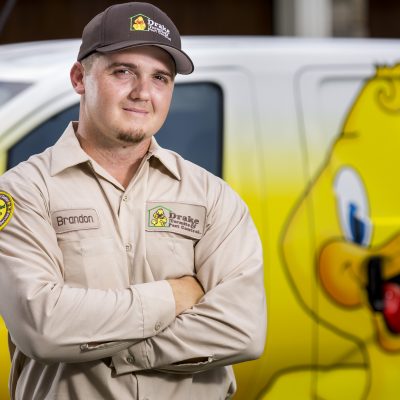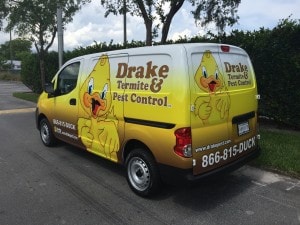Termites are one of the most destructive pests in Central Florida — and one of the most misunderstood.
They don’t just show up and cause immediate damage. In fact, the worst infestations often go unseen for years. And by the time you notice the signs, the damage is already done.
At Drake Lawn & Pest Control, we take termites seriously. That means understanding exactly what kind of termite we’re dealing with — and using targeted, effective solutions that work for your specific situation.
In this video, we’ll break down:
- The three major types of termites we see in Central Florida
- How to spot the signs early
- And why tenting isn’t the only option — or even the best one
Let’s dive in.
1 – DRYWOOD TERMITES
First up: Drywood termites.
Drywood termites (Incisitermes minor) are a unique species that live entirely inside the wood they infest — no need for soil contact or moisture from outside sources. That makes them a particularly sneaky and self-sufficient pest.
What They Look Like:
- Swarmers (Alates): These are the only termites that leave the colony — flying out to start new ones. They’re about ½ inch long with smoky dark wings and an orange-brown head and body.
- Soldiers: These have big reddish-brown heads and strong black mandibles. One unique feature? Their third antenna segment is extra thick, helping to ID them.
- “Workers”: Drywood termites don’t have a true worker caste. Instead, younger termites (called pseudergates) do all the labor and can still develop into soldiers or swarmers later.
Life Cycle & Behavior:
Swarming usually happens on warm, sunny days — often in fall but sometimes earlier in hot areas or indoors. Once they land, swarmers break off their wings, pair up, and find a small crevice in wood to start a new colony. The queen lays just a few eggs the first year, and it can take 5–7 years before any visible damage appears.
Colonies grow slowly, but mature ones can include thousands of termites. Queens become visibly swollen over time (a condition called physogastry), while kings stay mostly the same.
Survival Skills:
These termites are built for dry climates — they pull moisture from the wood they eat or make it internally. They even reabsorb water from their feces to stay hydrated, which is why their droppings are so dry and gritty.
Unlike other termite species, drywood termites don’t need soil contact or high moisture to survive. They can live entirely inside dry wood — from your furniture to your crown molding to the structural beams in your attic.
They sneak in through small cracks and crevices, then hollow out galleries inside the wood itself. Because they don’t need to come out to the soil for moisture, you might not see obvious mud tubes or surface signs — which makes them harder to detect.
Over time, though, you might notice:
- Frass — this looks like fine, sand-like pellets and is actually their droppings
- Kick-out holes, where they push that frass out
- Bubbling or blistering paint, caused by internal tunneling
- And occasionally, discarded wings from swarmers
Their colonies grow slowly — which sounds good at first — but that also means they can go undetected for years, quietly damaging your home from the inside out.
They typically swarm in late summer into fall, but they can also swarm indoors during warm weather, even in winter if conditions are right.
Drywood Treatment
So… what’s the solution?
This is where Drake is different.
Most companies will default to tent fumigation. It’s the most common industry recommendation. But here’s the truth:
Tenting is a nightmare for homeowners.
It requires:
- Leaving your home for 2–3 days
- Bagging up all your food, medicines, and pet supplies
- Potentially removing indoor plants
- And dealing with chemical residues, cleanup, and stress
It’s invasive, expensive, and disruptive. And while it may kill the termites present during the fumigation, it doesn’t prevent new infestations.
That’s why we don’t offer tenting.
At Drake, we believe in targeted, intelligent solutions that solve the problem without turning your life upside down.
We use:
- Localized injectable foams, directly into infested wood
- Surface wood treatments that penetrate and eliminate colonies
- Careful inspection and sealing of entry points to prevent re-infestation
These methods are effective, far less invasive, and help you avoid going through the tenting process altogether. Our goal is to catch drywood termites early — and treat them precisely, so you can stay in your home and stay protected.
2 – SUBTERRANEAN TERMITES
Next, let’s talk about subterranean termites — the most common type in Florida and the ones responsible for the majority of structural damage we see.
Swarmers (Alates): About 3/8 inch long with dark brown to black bodies and long, translucent wings slightly longer than their bodies.
These winged, reproductive termites are frequently mistaken for flying ants, but are smaller and have straight, rather than bent, antennae. Also, termite swarmers are generally much more destructive than ants.
Peak swarming periods for subterranean termites occur from January through May in Florida. An infestation begins when warm temperatures and heavy rainfall trigger an established colony to send out a swarm of these winged termites to start a new colony, which is sometimes, unfortunately, your home. Once a swarmer lands, it sheds its wings, mates, and becomes a primary reproductive—king or queen—of the newfound colony.
- Soldiers: Have large yellowish-brown heads and curved mandibles for defense.
- Workers: Creamy white, soft-bodied, and wingless, these termites handle all the foraging and colony care.
Survival Skills:
Subterranean termites rely on moisture and mud tubes to navigate dry environments. They share food and microbes essential for digesting wood through mouth-to-mouth feeding, making them highly social and efficient at damaging wooden structures.
Unlike drywood termites, subterraneans live underground. They need moisture to survive, so they build mud tubes to travel between the soil and the wood in your home.
Unlike drywoods, they must stay in contact with soil moisture and don’t live entirely inside wood.
They often enter through:
- Expansion joints in the foundation
- Cracks in the slab
- Plumbing or utility penetrations
- Or even from wood that touches soil, like decks and porches
Once inside, they can chew through wood, drywall, even insulation — all while staying hidden from sight.
Signs of subterranean termites include:
- Mud tubes along walls or foundations
- Swarms, especially in spring after rain
- Hollow-sounding wood
- Buckled floors or sagging ceilings
3 – FORMOSAN & ASIAN TERMITES
Now let’s talk about Formosan and Asian subterranean termites — sometimes called “super termites.”
These aggressive species are invasive, highly destructive, and capable of causing major structural damage in just a few months. Formosan termites, in particular, build massive colonies — sometimes in the millions — and create intricate mud carton nests in walls, attics, or trees.
Asian subterranean termites, common in South Florida but increasingly spreading, behave similarly but swarm in the early evening and are drawn to light sources.
- Swarmers (Alates): Larger than native species—about ½ inch long—with yellow-brown bodies and noticeably hairy wings.
- Soldiers: Formosan soldiers have teardrop-shaped heads and oval jaws, while Asian soldiers have more rectangular heads and slightly curved mandibles. Both types excrete a white, defensive fluid when threatened.
- Workers: Nearly identical to other subterranean workers—pale and soft-bodied—but they belong to much more aggressive colonies.
Life Cycle & Behavior:
Super termite swarms are intense, often happening in late spring to early summer. Formosan termites can nest above ground in walls or attics by building carton nests—a mud-like material made from wood and saliva that holds moisture. That means they don’t always need soil once established.
Survival Skills:
Formosan and Asian termites are more heat-tolerant and moisture-adaptable than most species. Their carton nests let them survive in hidden, above-ground spaces. Once established, they’re extremely difficult to remove.
Both species require:
- Immediate identification
- Aggressive treatment
- And ongoing monitoring
These aren’t the termites you can wait on. If we find signs of Formosan or Asian termites, we act fast and thoroughly — because the damage they cause escalates quickly.
Subterranean Treatment
Long-Term Protection
To treat subterranean termites, including Formosan and Asian termites, we take a multi-step approach.
It starts with:
- A detailed inspection to locate activity and entry points
- Then, we install a liquid treatment zone around your home’s foundation using Termidor® — the gold standard in termite control.
After trenching around the perimeter of the building, we treat it with Termidor which begins working in hours to gain complete control of termites. It only needs to be applied once every 10 years, whereas bait stations typically require inspections 1-4 times a year. This is because bait stations that are damaged by weather become ineffective and need to be maintenanced or replaced.
Termidor doesn’t repel termites. It’s undetectable to them — which means they walk right through it, carry it back to the colony, and spread it like a virus. Within days, the entire colony is eliminated.
This creates a protective barrier that keeps termites out long-term — with regular monitoring to ensure it stays strong.
So here’s the big takeaway:
Not all termites are the same — and not all termite treatments should be, either.
At Drake Lawn & Pest Control, we tailor every solution to your home, your situation, and the specific termite species at play.
We believe in:
- Minimally invasive treatments
- Smart, science-based strategies
- And avoiding outdated, stressful options like tenting whenever possible
We protect your home like it’s our own — with experienced technicians, reliable treatments, and a commitment to doing things right the first time.
If you’re seeing signs of termites — or just want peace of mind — schedule an inspection today. We’ll walk you through everything, answer your questions, and give you a plan that actually works.
Because when it comes to termites, you want more than just a treatment — you want real protection.


